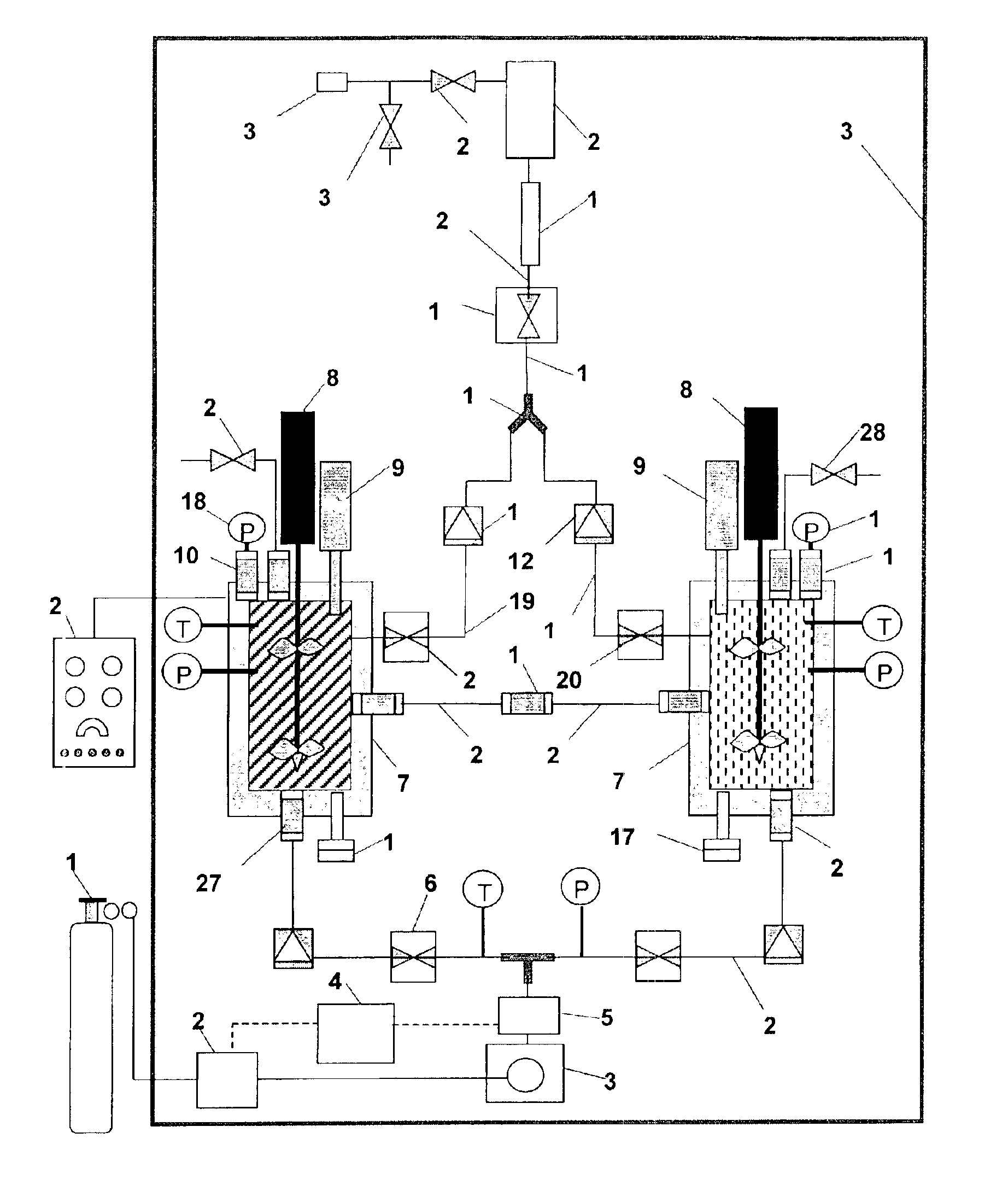Process for mixing particulates
a technology of particulate mixture and mixing process, which is applied in the direction of separation process, weaving, explosives, etc., can solve the problems of increasing the use of organic solvents increases the cost of capturing, removing, and/or disposing of organic solvents, and the removal of organic solvents increases the risk of undesirable or uncontrolled reaction
- Summary
- Abstract
- Description
- Claims
- Application Information
AI Technical Summary
Problems solved by technology
Method used
Image
Examples
example 1
[0060]An experiment was run in a mixing vessel to test the effect of dense phase CO2 on aluminum nanopowder. The reductive potential of aluminum is well known and is sufficient to reduce water into hydrogen gas and oxygen or carbon dioxide into carbon and oxygen. Control experiments were run to verify that no reaction would occur between aluminum nanopowder and CO2 at normal operating conditions. A small powder (35 nm) with a thin oxide shell (2.0 nm), 61.0% aluminum content, was selected to represent an extreme test of the reaction. Typically, powders of this quality are the most reactive and have been shown to reduce water the most readily in previous experiments.
[0061]Standard mixing conditions were simulated in a single mixing vessel by adding 2.5 grams of aluminum powder from Lot # Al1A to the bottom of the vessel and sealing the material inside. The vessel was pressurized to 70 bar and stirring began at a rate corresponding to 1.4 bar inlet pressure on the pneumatic stirrer. S...
example 2
[0063]The performance of the mixer was tested by mixing aluminum nanopowder with nanometer sized Al2O3 (alumina). The nano-alumina (purchased from Nanophase Inc.) acted as a surrogate for MoO3 in all mixing experiments. The advantages of nano-alumina as a surrogate for molybdenum trioxide included: the lack of reactivity between Al and Al2O3; the availability and low cost of high quality nanometer-sized alumina; alumina's inert properties (TGA, in CO2, reactivity with Al etc.); and the contrast in color between Al2O3 (white) and aluminum nanopowder (black). Shortcomings of alumina as a surrogate for nanoscale MoO3 include: the inability to measure performance data for the mixtures; the inability to distinguish Al and Al2O3 by electron microscopy; and the difference in shape between alumina (spherical particles) and MoO3 (rod like particles).
[0064]The powder was delivered to the collection chamber and analyzed. The TGA and BET are shown in the following Table:
[0065]
Table Representati...
example 3
[0067]This example illustrates the mixing of nanoaluminum powder and molybdenum trioxide powder. In a continuous operation at a collection rate of 200 g / hr, a first five-liter stainless steel mixing vessel is pre-filled with 140 g of nanoaluminum powder and a second five-liter stainless steel mixing vessel is pre-filled with 260 g of molybdenum trioxide powder. Each mixing vessel is sealed and a high-pressure piston pump delivers compressed CO2 from a storage cylinder to each mixing vessel at a pressure of 1000 psi. Once pressurized, each powder solution is vigorously mixed with a magnetically coupled mechanical stirrer within each pressure vessel. Each powder solution is simultaneously exposed to ultrasonic energy at 200 Watts to disperse and wet the particulates within the compressed CO2. Once the solutions are thoroughly dispersed, each solution is fed to a static mixer through ⅛″ stainless steel tubing. The dispersions are subjected to multiple flow patterns within the static mi...
PUM
| Property | Measurement | Unit |
|---|---|---|
| thermodynamic energy density | aaaaa | aaaaa |
| thermodynamic energy density | aaaaa | aaaaa |
| outer diameter | aaaaa | aaaaa |
Abstract
Description
Claims
Application Information
 Login to View More
Login to View More - R&D
- Intellectual Property
- Life Sciences
- Materials
- Tech Scout
- Unparalleled Data Quality
- Higher Quality Content
- 60% Fewer Hallucinations
Browse by: Latest US Patents, China's latest patents, Technical Efficacy Thesaurus, Application Domain, Technology Topic, Popular Technical Reports.
© 2025 PatSnap. All rights reserved.Legal|Privacy policy|Modern Slavery Act Transparency Statement|Sitemap|About US| Contact US: help@patsnap.com



